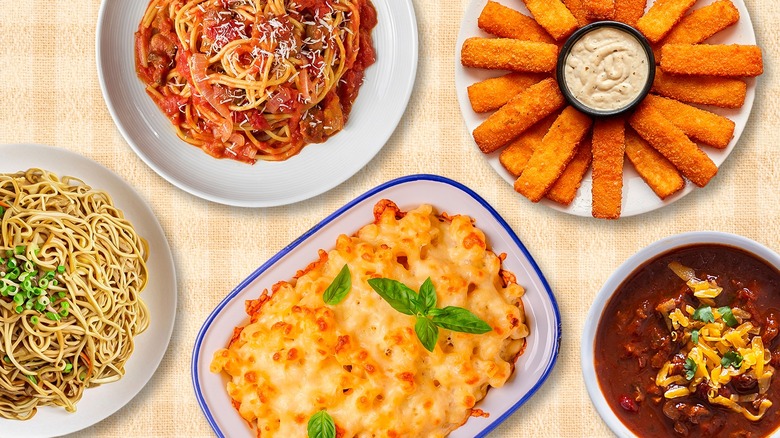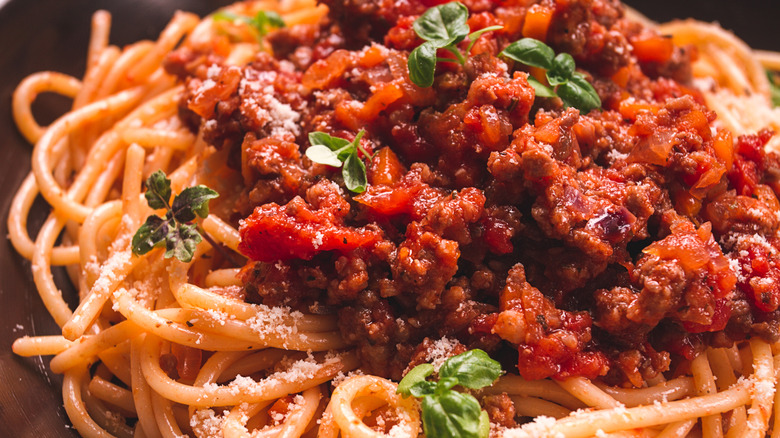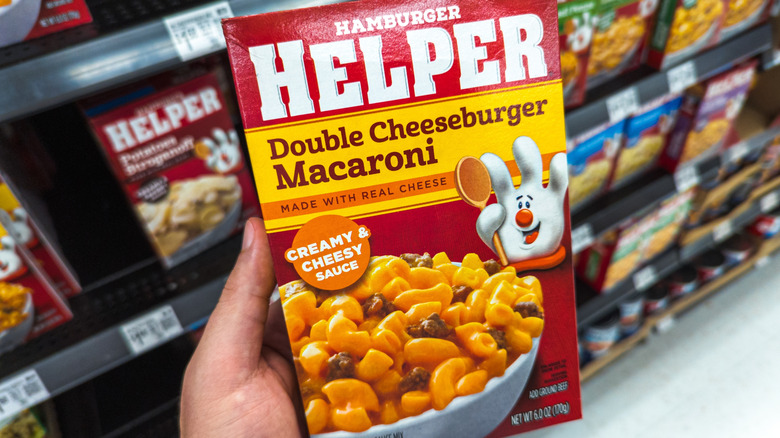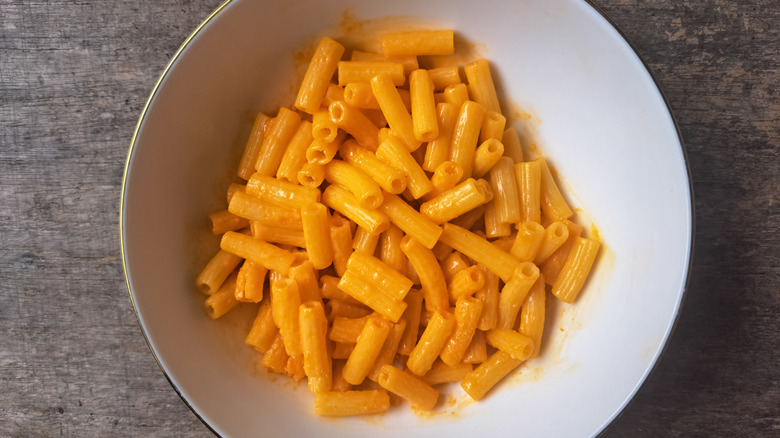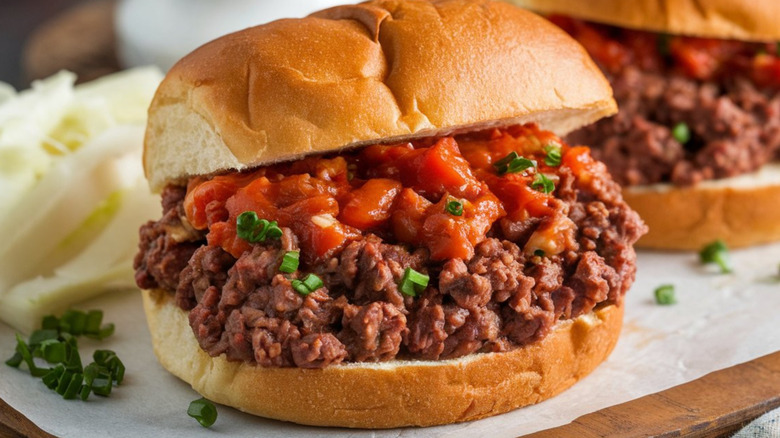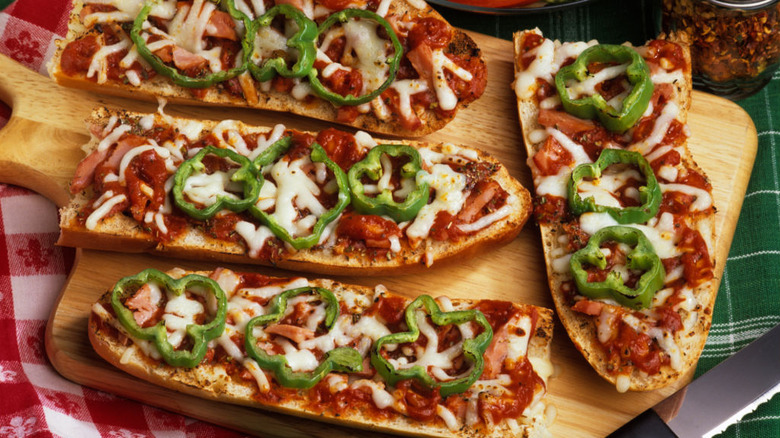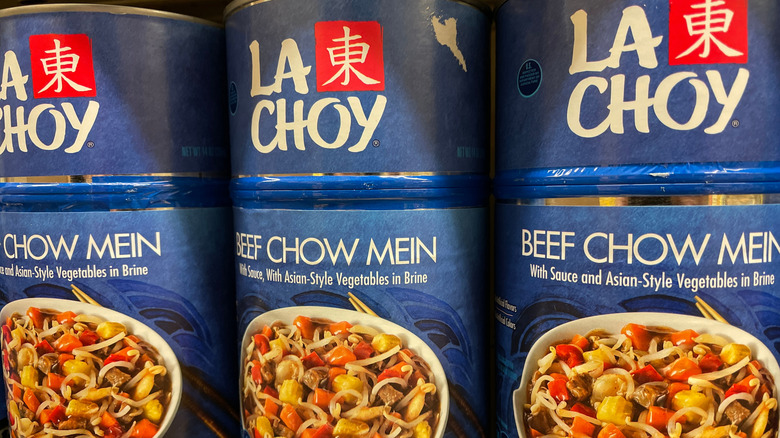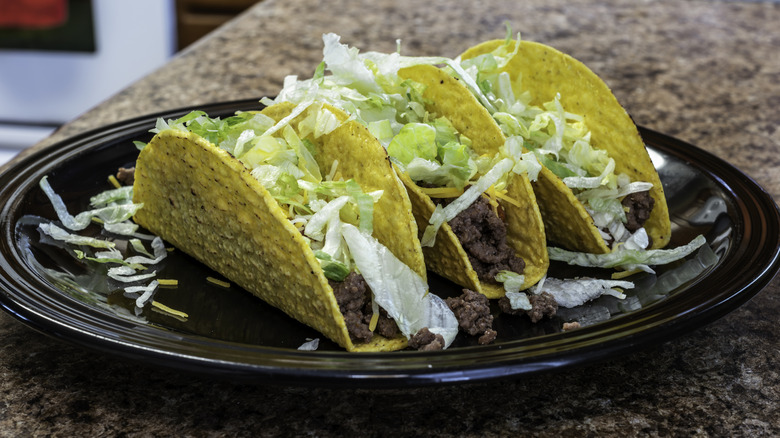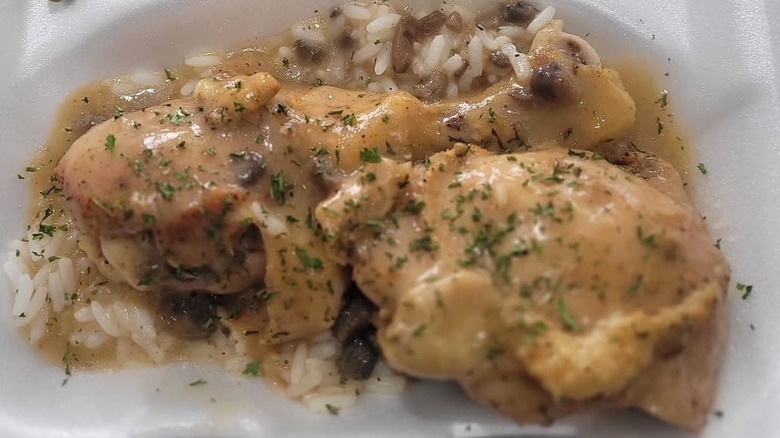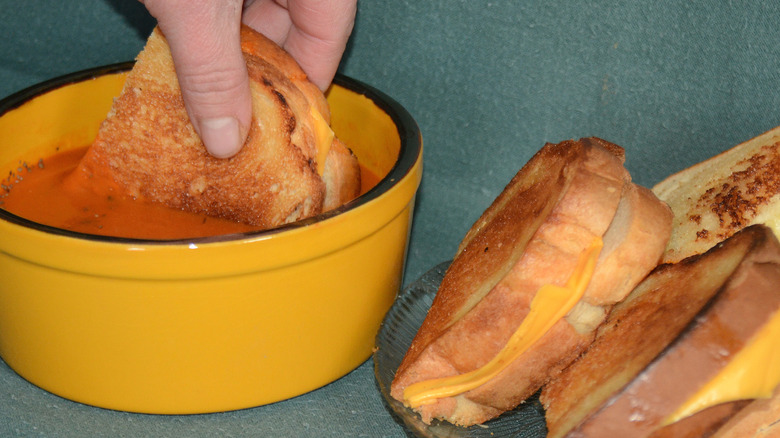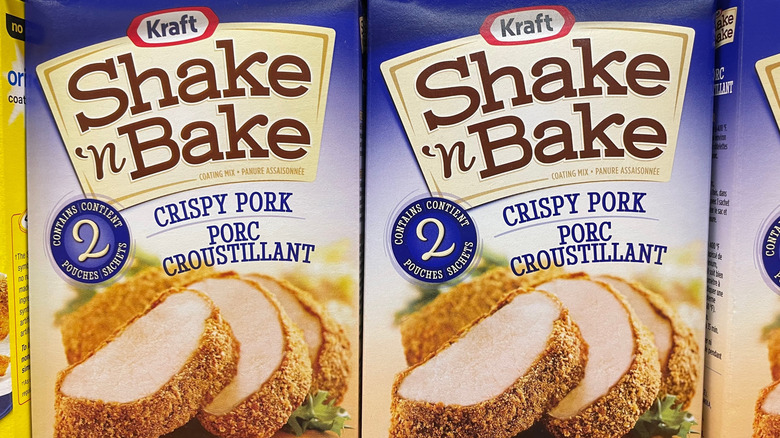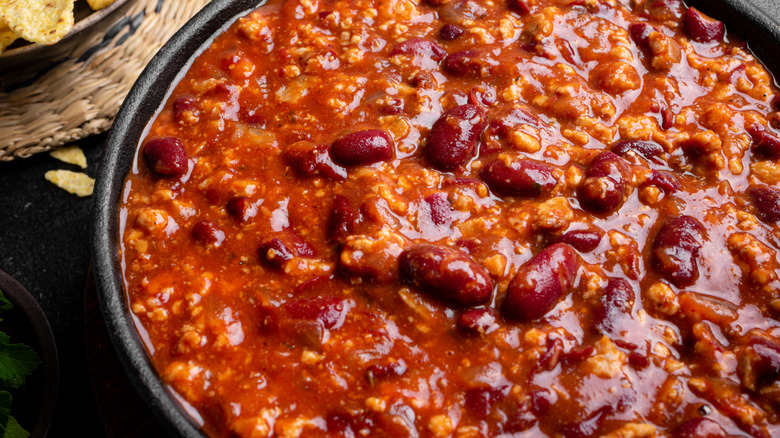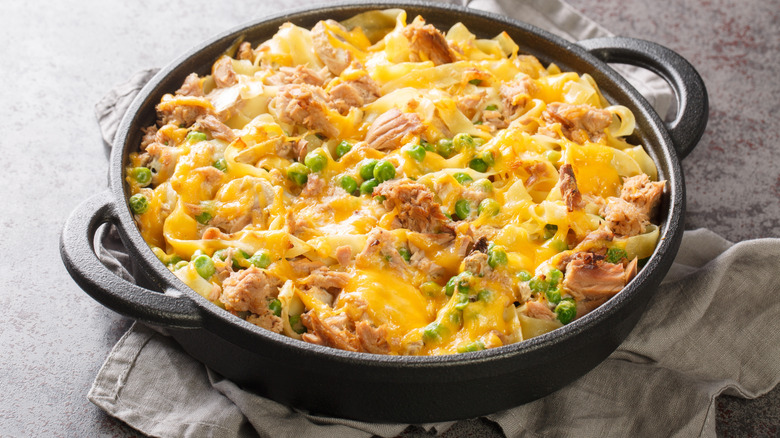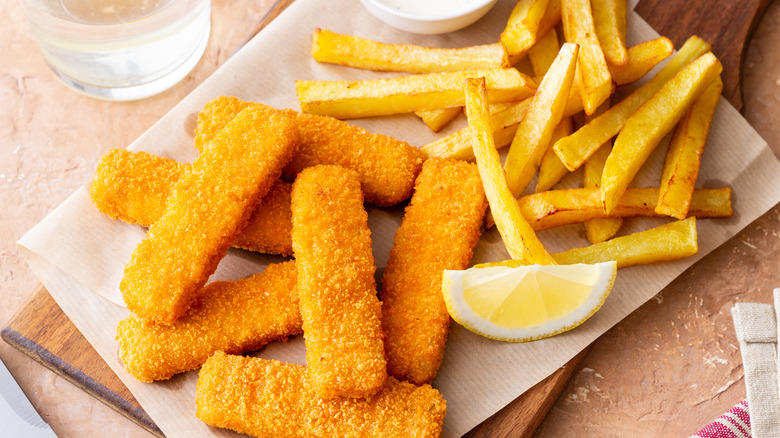13 Old-School Dinners '80s Kid Survived On Week After Week
Out here in the 21st century, "American food" covers a wonderfully large array of things. The influx and influence of culinary cultures from around the world, along with the ability to spread the word and love of new foods via dedicated food TV channels, social media, and food blogs and websites, has stoked curiosity to the point where the options for what to buy to make dinner at even the most average supermarket are virtually endless.
It just wasn't that way back in the 1980s. There wasn't so much product diversity or cultural diversity when it came to food. For the most part, the U.S. was a middle class nation and families ate mostly the same stuff, week after week, when it came time to gather for family dinner. Why? Because there wasn't as much to choose from at the store, and these crowd-pleasing meals got the job done for not a lot of money. The memories of such dishes range from fondness to disgust, but these really were what was for dinner on any given night in the 1980s, likely served alongside a stack of white bread, canned or frozen vegetables, and big glasses of milk.
Spaghetti
A plate of pasta tossed with a rich and hearty marinara sauce is a very old Italian tradition, brought to the U.S. via a period of substantial migration in the late 19th and early 20th centuries. But that scratch-made meal from treasured family recipes isn't the spaghetti of the 1980s. By then, spaghetti meant dried noodles from a box, cooked for just a few minutes in boiling water. It was topped with a massive spoonful of marinara-inspired sauce that came from a jar made by the likes of Ragu or Prego, with some thickening and protein-provided browned ground beef added in while it simmered. The final, finishing touch: parmesan cheese, but nothing authentic — rather Kraft's powdered parmesan shaked out of a can.
Premade spaghetti sauces hit the mainstream in the U.S. in the 1970s and were well entrenched by the 1980s, thanks in part to the proliferation of multiple variants of Prego and Ragu. Developed specifically to meet the tastes of Americans, those sauces moved spaghetti night out of being an all-day process into an inexpensive weeknight meal option.
Hamburger Helper
Lots of vintage casserole dishes vanished from the dinner table because they just became too time-consuming to make, and many were replaced by Hamburger Helper. One box represented one entire hot meal, often made in just one pan, that could feed a whole family. It contained some pasta and a sauce, and required the addition of a pound of cheap ground beef to be transformed into a casserole that could be served in minutes. Cheeseburger macaroni, chili tomato, four cheese lasagna, chili mac, and stroganoff varieties proved particularly popular in the 1970s and 1980s with American families led by working parents who didn't have the time or energy to make a meal from scratch.
Hamburger Helper virtually dominated the easy casserole space in the latter decades of the 20th century, introducing Tuna Helper and Chicken Helper varieties. With food prices rising in the 2020s, Hamburger Helper kits are once again a top seller, as today's adults fondly remember these economical, filling, and salty relics of their childhoods.
Macaroni and cheese
Just because it's made in a pot on the stove and is served hot doesn't make a meal homemade or healthy. But macaroni and cheese, the kind made from a box manufactured by the likes of Kraft, has been a universally popular meal for kids for decades – particularly in the 1980s – and it certainly felt like a home-cooked meal. Water had to boil to make sure those tiny pieces of elbow pasta got soft, and it needed a little bit of milk and water to finish the cheese sauce made possible by the highly scientific and mysterious sealed envelope of salty, bright-orange, cheddar-flavored powder.
One box could feed a few kids or a whole family for virtually pennies a serving. Some Kraft Macaroni and Cheese could also serve as the foundation of a slightly fancier and heftier meal. Canned tomatoes and ground beef turned it into something resembling a casserole, while cut-up hot dogs or smoked sausage (cooked on their own or thrown in with the pasta) added some very cheap protein to turn what was otherwise a pile of nutritionally vapid carbohydrates into a somewhat balanced meal.
Sloppy Joes
Now considered a sandwich that people don't really eat anymore, from the 1940s until the 1980s or so, the sloppy Joe could be found on restaurant and cafeteria menus all over the U.S., if not on the regular rotation of easy, cheap, and crowd-pleasing dinners in millions of American homes. Who is the "Joe" behind the sloppy Joe? Likely no one, but the name was shorthand for a hot, dinner-worthy, cooking-required sandwich made from cooked and pebbled ground beef swimming in a thick and messy sweetened tomato sauce, derived from tomato sauce, barbecue sauce, or ketchup. Served on a hamburger bun and possibly with chopped onions and peppers fortifying and stretching the meat, and maybe a slice of cheese melting over the filling, sloppy Joes really took off as something pleasant that parents could make for kids by the 1970s. This was the time when Libby's canned sloppy Joe sauce and Hunt's Manwich vied for supermarket attention.
Sloppy Joes have since fallen out of fashion, in restaurants and at home, perhaps because they're a bit more labor-intensive than cold sandwiches or stovetop-requiring meals like mac and cheese. But multiple generations of adults now look back nostalgically on this comfort food of the past.
Homemade pizza
Pizza was huge in the 1980s of course, and while many old-school pizza chains quietly disappeared after dominating the decade, the beloved combo of bread, tomato sauce, and cheese was a favorite in the kitchen, too. The best homemade pizzas are the easiest to make, and it was a big treat for '80s kids when they got to make a special pie of their own, to their own specifications, for a random weeknight dinner.
There were lots of pantry and freezer staples that made pizza night at home possible in the 1980s. Stouffer's sold a line of frozen personal pizzas each made from a quarter of a loaf of a French-style baguette. That was certainly the easiest to prepare option, although kids could also make dinner for themselves if the meal was English muffin pizza: Instead of a crust, they just spread some canned tomato sauce and sprinkled some mozzarella on two halves of an English muffin.
Commercially available pizza crusts, or do-it-yourself kits, made a semi-homemade pizza an easy dinner idea. Chef Boyardee's shelf-stable boxes of pizza ingredients included the sauce and a powder that turned into dough when water was added, while Boboli went national in the mid-1980s with a selection of ready-to-top crusts that it marketed as "bread shells."
Chow mein
At the dawn of the 1980s, the most widely consumed international cuisine in the U.S. was Chinese food — or rather the heavily modified, commodified and westernized stuff found at restaurants that called themselves "Chinese-American" in small print on the menu. The demand for Chinese-inspired food was such that two brands of canned and packaged versions of restaurant favorites vied for pantry and dinner table space in the U.S.: Chun King and LaChoy.
Families needed to cook up a pot of rice or a box of frozen egg rolls to serve alongside a heat-and-eat large can of chop suey or chow mein, consisting of shredded veggies like celery, bean shoots, and peppers, and diced chicken or beef in a salty and gloopy sauce. Crispy fried noodles went on top for a garnish, soy sauce was sprinkled on top, and this passed for something exciting in the homes of millions — or at least as a reasonable alternative to pricier Chinese takeout.
Crunchy shell tacos
In the 1960s and 1970s, the spread of Taco Bell from Southern California across the U.S. popularized and demystified the taco. An extremely commonplace meal or snack across Mexico, with dozens of variants persisting over the centuries, those tacos didn't look much like the version that became a popular home-cooked dinner treat in American kitchens in the 1980s. Traditionally made with beans or stewed and shredded meat in small tortillas, mainstream American tacos were prepared largely the same way that Taco Bell did: ground beef simmered in water and a packet of mildly spicy taco seasoning made by a spice company, spooned into tortillas fried until crispy and then packaged, and topped with non-historically Mexican ingredients like shredded cheddar cheese and iceberg lettuce.
Tacos are so associated with the 1980s in part because that's when the concept of "Taco Tuesday" emerged. Restaurants far and wide had taco specials on that night of the week, and the alliterative fun extended to households, who stocked up on boxes of taco shells and ground beef.
Cream of mushroom chicken bake
More formally known as One-Dish Chicken and Rice Bake, this casserole is hot, soft, plentiful, and inoffensive. It's also predictable enough in flavor to appeal to almost any palate, making it a great dinner for a large number of families. The recipe, which requires a can of Campbell's Cream of Mushroom soup, first appeared on labels of that soup back in the 1950s, and the generation who grew up eating it as kids served it to their families when they came of age in the 1980s.
As One-Dish Chicken and Rice Bake is a fairly bland dish, its appeal lay in how easy and fast it was to prepare, not to mention inexpensive. It utilized just a can of condensed soup, water, rice, a pinch of paprika, and a little more than a pound of skinless and boneless chicken, which was a massive hit upon its general marketplace arrival in the 1980s. How does it taste? Very mild, like white meat chicken, a little rice, and some cream with a hint of mushroom.
Soup and sandwiches
Lots of people enjoy the occasional novelty of breakfast for dinner – and back in the 1980s, plenty of kids also got to have a nighttime meal that looked suspiciously like what they may have otherwise eaten for lunch. Soup is a classic light midday meal, and a sandwich is the quintessential lunch food, but put them together, and you've got a substantial and hearty combo, no matter what time of day it's consumed.
A parent could feed a kid for not much money on a serving of soup and some lunchmeat slapped between two pieces of purchased bread. While moms and dads certainly prepared whatever soups and sandwiches were their kids' particular favorites, combinations that endured into adulthood developed in this time, perhaps none more so than a bowl of creamy tomato soup with an ooey-gooey grilled cheese sandwich, which made for great dipping. Chicken noodle, chicken with rice, bean with bacon, and beef vegetable would also have factored into the rotation. The popularity of soup and sandwich was such that in the late 1980s, Campbell's tried to make it an even easier meal to prepare, rolling out the microwavable Souper Combo frozen dinners.
Breaded pork chops
Pork chops can sometimes be so boring, just laying there in a pan on the stove or getting roasted in the oven until they're no longer pink in the middle and hopefully retaining some moisture. There's also not always a lot of natural flavor in pork chops, which is probably why Shake 'n Bake was such a popular porcine treatment in the mid to late 20th century. Seeking to turn pork into something like boneless fried chicken cutlets, consumers were instructed to take a boxed bag of what was essentially seasoned bread crumbs, put some pork pieces in there, seal it up, and then vigorously shake until it was coated all around. After the shaking, came the baking, in an oven, until a crispy, tasty outer layer formed around the hot and juicy pork inside.
As the ads for Shake 'n Bake famously declared over the years, it was so easy to use that even kids could lend a hand: "It's Shake 'n Bake and I helped!" a young actor declared (via YouTube). There were plenty of other, more homemade ways to give pork chops a nice breading, but Shake 'n Bake was so undeniably and irresistibly simple, that it became a regular dinnertime tool from the 1960s through the 1980s and beyond.
Chili
Chili is a distinctly American dish, although regions of the U.S. define a good bowl in many different ways. Cincinnati chili is done right when it's a sauce that goes on spaghetti and under cheddar cheese, while Texas doesn't use beans in its beefy and chunky chili. However it was made across the country in the U.S., it became a commonly made dinner because it's just so easy to make. You just set and forget the inexpensive ingredients — ground beef, various canned goods and spices — in a big pot to let them simmer and merge together for a few hours.
Countless families had their own recipes for chili, or a soup akin to it, while chili remained readily available for takeout to feed a brood of kids a calorie-rich and warming meal for not a lot of money. Canned chili was an especially affordable and fast dinner solution — simply dump into a pot and let it heat up on the stove, or put it in a couple of bowls and it's ready to eat in minutes if prepared in that newfangled '80s appliance called the microwave.
Tuna noodle casserole
Known as hotdish in the Midwest or a casserole in most of the rest of the country, a baked concoction of a starch base, creamy canned soups, a protein, veggies, cheese, and a crunchy topping was often what was for dinner in the 1980s. One of the most consumed casseroles of all was tuna casserole, however parents chose to make it.
Tuna noodle casserole almost always started with a big bag of egg noodles, boiled in water until soft, and then placed in a long and wide dish. Into that went cans of cream of mushroom soup, a can of tuna or two, and perhaps some frozen peas, diced fresh onion, and a heap of shredded cheddar cheese. Some more cheese probably went on top to crisp up into a crust as the casserole cooked, along with whatever was in the pantry to provide crunch. Tuna casserole was a bit soggy and wet, if not for the textural boost with a layer of crushed potato chips or Ritz crackers.
Fish sticks
"Fridays during Lent meant no chicken and no beef. That meant Mrs. Paul's fish sticks for dinner," one Reddit user wrote on a board discussing growing up in the 1980s. In Lent, the 40-day lead-up to Easter, Roman Catholic Church adherents eschew meat on Fridays to practice atonement, and fish sticks were a fast food-adjacent meal centerpiece. The American take on the iconic British meal of fish and chips, a few fish sticks taken out of a big bag or box kept indefinitely in the freezer. Along with a handful of frozen french fries tossed onto the same baking tray, it turned into a meal that pleased kids and didn't require much work.
Fish sticks were apparently very cheap to produce. In addition to Mrs. Paul's, companies like Gorton's and Birds Eye sent out giant packages of fish sticks to stores in the 1980s, all of the pieces exactly the same and thus appetizing at first sight to even the pickiest of young eaters. Fish sticks, then and now, are perfect rectangles of pressed and formed whitefish coated in a thin and barely seasoned breading.
